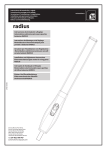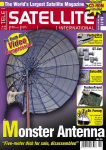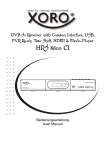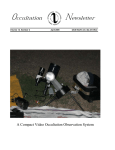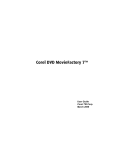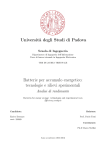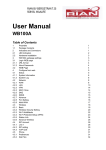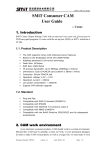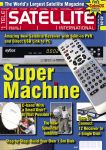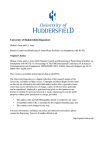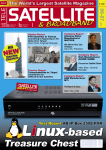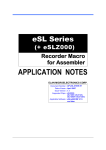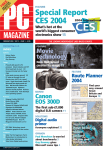Download TOPFIELD TF7700HSCI HDTV - TELE
Transcript
The World’s Largest Satellite Magazine SATELLITE INTERNATIONAL SoR 02-03 £ 3.95 2007 27th Year Nº 197 TELE EUROPE 5.90€ HD SD T S R FI V T HD ST TE TOPFIELD TF7700HSCI HDTV The Age of HDTV Company Report Manufacturer Jiuzhou, China SMiT’s CEO Xueliang Huang Tells a Success Story The 4 Points to Growth by Jiuzhou’s Directors David, Linda and Huang UKE Company Report CAM Producer SMiT, China Best Satellite Companies in Thailand Meet the Best of the Satellite Trade in Bangkok Jon Clarke of JSAT.TV Niran Tangpiroontham of INFOSAT Exclusively for TELE-satellite Readers SatcoDX “World of Satellites” ������� �������� ���������� ���� SatcoDX’s “World of Satellites” Software contains the technical data from every satellite transmission worldwide SatcoDX Software Activation Code Version 3.11: 655CFFB8897CE37DA499G399232482BE Valid until the publication of the next issue of TELE-satellite magazine Download SatcoDX Software here: www.TELE-satellite.com/cd/0704/eng TELE Step by Step Guide to Get SatcoDX Software Running on Your Computer: 1. Download SatcoDX Software Version 3.10 from the above URL, or install from CD-ROM SATELLITE INTERNATIONAL Note: if you have already installed Version 3.10, you do not need to do it again. Check your currently installed version by clicking the HELP button, then ABOUT. The third line tells you the version installed on your computer Main Address: TELE-satellite International PO Box 1234 85766 Munich-Ufg GERMANY/EUROPA UNION Editor-in-Chief: Alexander Wiese [email protected] Published by: TELE-satellite Medien GmbH, Germany Design/Production TELE-satellite Hungary Kft Nemeti Barna Attila 2. Enter the Activation Code by clicking LICENSE and then REGISTRATION. After entering Activation Code click VALIDATE KEY and EXIT. Now you are ready to download the newest satellite transponder data anytime you want, provided your computer is connected to the Internet and is allowed to access FTP. Note: SatcoDX Software also runs without Activation Code, or with an outdated Activiation Code. However, the satellite data on display will be either from last time you performed an update, or from the time when original software has been compiled. By default, each SatcoDX software contains the set of satellite data as current as when it was compiled and put together. International Advertising Alexander Wiese [email protected] CITY Advertising Monika Szabo [email protected] Complete Channel Lists from Every Satellite With all Technical Data Subscriptions Services See Page 50 Newsstands Distributors TELE-satellite English Edition Austria: Pressegrossvertrieb PGV Canada: Disticor China: LSG Derong Trade Co. Estonia: As Lehepunkt Finland: Rautakirja Oyi Greece: Hellenic Distribution Ireland: Eason & Son Israel: Steimatzky Lebanon: Levant Group Malta: Miller Distributors Nigeria: Newsstands Distribution Norway: Narvesen Norge AS South Africa: MCS - Caxton Sweden: Svenska Interpress AB Thailand: Infosat Intertrade UK: International Press Network USA: Prestige Periodicals Automatic Display of all Receivable Satellite Channels Automatic Programming of SatcoDX Compatible Receivers Data Updates via Internet Anytime via Main and Backup Servers Copyright © 2007 by TELE-satellite ISSN 1435-7003 Print Channel Lists With Satellite Footprints in HTML Format Printed in SPAIN/EUROPA UNION www.TELE-satellite.com/eng Save Chart Data in many useful file formats Member of Distripress Your cosmic eye ������������������ ������������������������������ �������������������������� �������������������������������������������� ���������������������������������������������� �������������������������������������������� EYCOS S 55.12 PVRH ����������������������������������������� Digital TWIN Receiver with 2 CI Slots and hard������������������������������������������� disks size up to 400 GB. Record-suspicious data transfer via USB 2.0 �������������������������������������������� (2 GB in less than 3 minutes). ����������������������������������������������� Preprogrammes for ASTRA, HOTBIRD and TÜRKSAT. ������������������������������������ ������������������������������������������ INNOVATION AWARD MAIN OFFICE: Eycos Multimedia Systems Co. Ltd 189-1, Kumi-dong, Bundang-ku, Seongnam, 463-810, Korea TEL +82-(0)31-716-2289 FAX +82-(0)31-716-2655 E-MAIL [email protected] WEB www.eycos.de EUROPE DISTRIBUTION AUSTRIA / GERMANY SATFORCE Kommunikationstechnik GmbH Mayrwiesstrasse 11 5300 Hallwang AUSTRIA TEL +43-(0)662-665-699-0 FAX +43-(0)662-665-699-20 E-Mail [email protected] WEB www.satforce.com TEL FAX E-MAIL WEB In the issue August 2006 of the magazine SATVISION, the Eycos Receiver S55.12 PVRH were decorated with the innovation price. Particularly the „PERFECT UPSCALE“ technology of the S55.12PVRH was emphasized. This technology guarantees brilliant colors, the best sharpness and a very detailed picture on modern plasma and LCD monitors out of a standard PAL TV signal. � � �� � � � � � ��������������������������������� ������������������������������������������������� �������������������������������������������������� � ����� ���������������������������������������� ��������������������������������������������� BENELUX Rian BV Bergstraat 25 5581 BL Waalre Nord Barbant. +31 (0) 40 221 36 56 +31 (0) 40 221 61 22 [email protected] www.gso.nu SWISS RADIO MATERIEL Hauptsitz : Av. des Baumettes 21 1020 Renens VD 1 TEL +41 (0) 21 633 58 00 FAX +41 (0) 21 633 58 01 MOBIL +41 79 413 32 26 E-MAIL [email protected] WEB http://www.radio-materiel.ch EYCOS S 60.12 PV2R Digital TWIN Receiver with 2 CI Slots and hard disks size up to 400 GB. Record-suspicious data transfer via USB 2.0 (2 GB in less than 3 minutes). Preprogrammes for ASTRA, HOTBIRD and TÜRKSAT. CONTENT EYCOS S55.12.PVRH Digital satellite PVR receiver with integrated scaler ............14 TOPFIELDTF7700HSCI Digital satellite receiver for SDTV/HDTV in DVBS and DVBS2 in MPEG2 and MPEG4 ................20 TECHNOTREND CONNECT S2-3600 USB box for reception of DVB and DVB-S2 in SDTV/HDTV ............24 SPAUN SMS 9989 U Extendable Multiswitch .....28 Beginner section: Monoblock Reception Problems ........10 Feature: HDMI – the interface not only for HDTV ............................12 Satellite technology: How do these electronic image wizards actually work? ......................18 Satellite reception: Multifeed reception – the Brazilian way ..............................32 Company report: Receiver Manufacturer Jiuzhou ..........36 Company report: CABSAT ...........................................38 Company report: CAM Producer SMiT ..........................40 Country report: Best Satellite Companies in Thailand ...44 Satellite reception: Made in Africa ..................................46 Satellite information: New Satellites ..................................48 Dear Readers 2007 will be the year of HDTV. In this issue of TELE-satellite you will not only find a test report on a genuine HDTV box, but also on a receiver with integrated 'scaler'. And you'll also learn in this issue what a scaler actually does. It's a device that takes an SD (standard definition) signal and miraculously transforms it into an HD (high definition) picture. when you've reached a point of absolute confusion. They advise you which device to buy, so that in this case they should help you decide whether to go for a HDTV receiver right away, or whether a receiver with integrated scaler will work just as well for your individual requirements. If you already own an HDTV-ready monitor but watch mostly SDTV channels, then a receiver-scaler could be fine for you. Seriously? So we don't need DVB-S2 any longer? Is HDTV now created in the receiver itself? Well, yes and no. Yes, because a scaler does a really brilliant job so that many viewers will be hard pressed to distinguish a true HDTV picture from scaler-created pseudo HDTV picture. However, if you already have the technical prerequisites to watch HDTV channels, then an HDTV receiver is the right thing for you. And at the same time no, because an electronic addition of pixels that are not there in the first place (and that's exactly what a scaler does) can never replace the original picture. So where do we go from here? If both means come more or less to the same end, which should be preferred? That's where the problems start, because the choice is getting bigger all the time, and the range of different devices and their functions is becoming almost endless. There's even a new profession emerging: so-called media guides. They can help you TELE-satellite helps you to become a media guide yourself. All the information you require can be found in TELE-satellite, even though the conclusions you reach might differ from ours. After all, there is no ultimate truth in satellite television. Your media guide, Alexander Wiese PS.: My favourite radio station this month is 'Rulet Radio' (11.013, H, A-PID 569, HOTBIRD 13 East), playing pop music from the Balkan countries without end, throwing in the same commercials every hour and generally offering 'true DX quality' as the signal apparently is taken from an AM radio station. ADVERTISERS ANGA CABLE 2007.................................46 ARION ................................................... 7 AZURE SHINE ........................................39 BAOTONG ..............................................10 CABSAT 2007 ........................................25 COMMUNIC ASIA 2007 ..........................34 DOEBIS ................................................8,9 DVB SHOP .............................................43 EMP .......................................................39 EYCOS ................................................... 4 FORTECSTAR .........................................35 6 TELE-satellite International — www.TELE-satellite.com GOLDEN INTERSTAR ............................. 41 GT-SAT ..................................................33 HORIZON ..............................................31 INFOSAT ...............................................47 INVACOM ..............................................23 JAEGER/WEISS .....................................21 JIUZHOU ...............................................52 KATHREIN .............................................37 MAX-COMMUNICATION .........................51 MOTECK ................................................27 MTI ....................................................... 5 PROMAX ................................................45 SADOUN ................................................49 SMARTWI ..............................................27 SMIT .....................................................19 SPAUN ................................................... 17 STAB .....................................................29 TECHNISAT ...........................................15 TELE-satellite CITY ...............................48 TOPFIELD .............................................. 2 BEGINNER SECTION Monoblock LNB Monoblock Reception Problems Heinz Koppitz A Monoblock is made up of two LNBs that are offset from each other by a fixed amount, typically 6°. This can lead you to believe that you should be able to receive satellites that are separated by that same 6° such as Astra1 and Hotbird or Astra 3A and Astra2/Eurobird without any difficulties whatsoever. But this idea doesn’t really hold water. This article will try to explain why and will also provide insight into whether an acceptable fine-tuning adjustment of the antenna is possible and how to go about actually doing it so that the best possible reception of both satellites can be obtained. The Problem Something unusual happens when you try to align to a satellite pair, especially the Astra1/Hotbird combination: after installing a monoblock on an antenna and aligning it with Astra1, the signal strength from Hotbird is either very weak or absent entirely. If you adjust the antenna to Hotbird, reception of Astra1 pays a price. The general rule has always been to align the weaker satellite to the centrally located LNB. Sometimes this helps, but this more or less just covers up the problem. And if you happen to live near the outer edges of Europe, you might say it’s your geographical location that’s at fault when the real reason is still being overlooked. 10 TELE-satellite International — www.TELE-satellite.com The Real Cause As it turns out, the design of the monoblock does not take the Earth’s physical characteristics into account. Monoblocks have a fixed LNB offset of 6°. Unfortunately, there is a problem with this amount: the actual separation between the two satellites as seen from the ground is more than 6°. So, what’s going on? The satellite belt is measured geocentrically – they orbit the center of the Earth at a distance of 42156 km (altitude plus the Earth’s radius). Every location on Earth, with the exception of the poles, is closer to the satellites. So, the satellites are actually more than 6° apart as seen from where you are standing. If you are on the equator, you are actually Monoblock LNB 6366 km closer (the Earth’s radius) to the satellites resulting in an increase in the actual satellite offset of more than 1°. In the middle latitudes this offset is still fairly significant with an average of 0.8°. Satellites that are 6° apart in their orbital slot (such as Astra3A and Eurobird) are actually closer to 6.8° apart as seen from the ground. This expanded offset does have its consequences. When the first satellite is perfectly aligned with the antenna, the alignment of the second satellite could be off by as much as 1°. An antenna with a beamwidth of 1° would only have weak reception at best. The situation could be even worse if the alignment of the first satellite is off by 0.3° in the wrong direction (away from the second satellite). This won’t be too much of a problem with reception of the first satellite but this would push the second LNB as much as 1.3° out of alignment with the second satellite resulting in no reception at all. A Solution The only possible way to receive both satellites at the same time would be to adjust the antenna such that both satellites are not providing maximum signal. As an example, we will discuss the Astra1/ Hotbird pair. With these two satellites it is especially critical since their orbital separation is actually more than 6°, namely 6.2°. This corresponds to a 7° offset from where you might be standing. 1. Align the LNB to Hotbird (13° east) for maximum signal. 2. Turn the antenna in the direction of Astra1 (to the east) just far enough so that the Hotbird signal has not begun to fall off. 3. Use the Astra1 LNB to control the reception of Astra1 (19.2° east). 4. Adjust the antenna as necessary until both satellites are providing equally good signals. Putting It All Together Monoblocks do not permit optimal adjustment of satellite pairs. The adjustment procedure presented here is really only when there is no other choice. It provides lower signal levels and is only usable when both satellites provide adequate signal – such as when the antenna is in the hot zone of both satellites. But even then, the bad weather reserve is greatly reduced. Monoblocks should be avoided altogether if you are on the edge of the satellites footprint. A multifeed antenna, that allows you to adjust the position of each individual LNB, would be a much better idea. As you can see, the offset angle from the Earth’s surface is larger than from the Earth’s center. www.TELE-satellite.com — TELE-satellite International 11 FEATURE HDMI HDMI – the interface not only for HDTV Peter Miller As HDTV is becoming more and more popular in Europe and other regions of the world, you have to forget about the old video outputs like SCART or composite video (RCA). They can not handle HDTV signal. What you can use is: wide bandwidth YPbPr, DVI or HDMI interface. During the first years of HDTV, only the YPbPr was used. The problem with the component analog output (YPbPr) is that its content is not protected from recording. So, it is not unusual that despite paying for viewing of the content, there will be no HD quality signal there. You have to use one of the digital interfaces: DVI or HDMI which both are copy protected with the HDCP system (Highbandwidth Digital Content Protection). HDMI (High-Definition Multimedia Interface) Gbps to 10.2 Gbps. HDMI 1.3 will support is the enhanced version of DVI (Digital Visual future devices with higher resolution, deeper Interface). The most obvious difference is: colors or higher frame rates. HDMI supports not only high definition video HDMI Type A & Type C connectors minimum only 2 channel PCM audio – all other but also audio. In fact, quite advanced audio. The difference between versions 1.0, 1.1 HDMI wins the battle with DVI not only due and 1.2 is in the supported audio formats as to wider functionality but also because it is well as some extra control possibilities. For HDMI 1.3 introduced new mini-connector backward compatible. To put simply, you may example: HDMI 1.1 supports DVD-Audio and called Type C. The standard one is called Type connect 2 devices even if one has DVI and the HDMI 1.2 – SACD (Super Audio CD). As you A. Type B with 29 pins is practically not used. other HDMI connector. You just need a suit- can see, HDMI is no longer limited for video The new mini connector is specially suited for able cable. Of course, you will have to connect signals. It is very useful for making intercon- hand held equipment: camcorders and digital audio signals with extra cables. nections in high-end audio equipment too. And still cameras. As we are at the connectors, it this is not all. Also computer graphic cards is good to mention something about cables. To and game consoles are more and more often be sure that a cable is capable of transferring equipped with this interface. signals of satellite HDTV (720p and 1080i) it Since its introduction in 2002, the HDMI connectivity standard has evolved from version 1.0 to version 1.3. HDMI supports HD formats are optional. should be marked as “Category 1” cable. “Cat- uncompressed video and 8 channels of uncom- However, you should keep in mind one egory 2” is required to pass 1080p signal and pressed audio starting from version 1.0. And thing: the fact that a device (like a TV-set) is if you do not have such signal sources, there all this with only a single cable. The standard equipped with an HDMI connector does not is no need to spend more money for that. The Type A connectors have 19 pins. The maxi- guarantee it will support all video and audio practice has shown that the length of the typi- mum bit rate of HDMI version 1.0 is 5 Gbps modes this interface is ready to use. You may cal copper cable should not be greater than 5 (the same as DVI). That is more than 2 times want to use AC3 audio from your satellite m (16 feets). Longer cables may cause loss of what satellite HDTV requires (720p or 1080i). receiver but your TV-set has only 2 loudspeak- data and severe distortion. HDMI may even be used with the 1080p sig- ers. What happens then? When connected and In satellite HDTV probably the most common nals @ 60 Hz refresh rates (not used in sat- powered, the sink device (TV-set) informs problem with digital interfaces is related to the ellite TV). There is no difference concerning the source device (satellite receiver) that it older TV-sets and HDCP protected content. video performance between versions 1.0, 1.1 handles only stereo audio. Then the source While most of the HDMI equipped TV-sets are and 1.2. All of them can support up to 8 bits adjusts its output and provides only stereo HDCP compliant, it is not that good with the per component in RGB 4:4:4 or YCbCr 4:4:4. signal (in digital form). However, if you con- older DVI interfaces. Some users have to turn Alternatively 12 bits per component for YcbCr nect the same satellite receiver to the suitable to the YPbPr interface if their TV-sets do not 4:2:2 (greater color depth at the cost of hori- A/V receiver equipped with 5+1 loudspeakers, support HDCP. zontal chroma resolution). Anyway, we have the Dolby Digital (AC3) will be used automati- 24 bits per pixel. cally. The user does not have to set it manually Despite the fact it was introduced just a – the source adapts to the sink. It is some- few years ago, more than 400 manufacturers The newest version (1.3) supports bit rate thing like plug-and-play functionality. So, you of consumer electronics have adopted HDMI up to 10.2 Gbps. The bandwidth has been dou- still have to carefully study the specifications standard. Tens of millions of devices equipped bled from 165 MHz to 340 MHz, what corre- of the equipment you want to buy: what video with this type of interface have been already sponds to the increase of bit rate from 4.95 and audio modes are really supported. Do not sold. All “HD Ready” marked TV-sets sold in be satisfied with the claim that this or that ver- Europe must include HDMI or DVI input. The HDMI connector – pin layout TELE-satellite International — www.TELE-satellite.com sion of HDMI is implemented. HDMI specs do computer industry is no lagging either. Moni- not mandate any video resolutions – it is like tor and graphic cards manufacturers also start connecting plug-and-play monitors to your to add this interface to their products. And PC. You use the same interface but the reso- what is really worth mentioning This standard lution you get depends on the monitor. The is backward compatible -something that we same goes true for audio. HDMI requires at often miss in other aspects of satellite TV. TEST REPORT Satellite receiver Eycos S55.12.PVRH PVR in premier league with HDMI In recent months an up-and-coming company from South Korea has made the headlines a number of times when it comes to new, innovative and technologically superior products. We're talking about The youngest Eycos receiver deserves the description 'quantum leap' without a doubt. Countless owners of plasma or LCD screens are furious about the often miserable video quality of many free-to-air satellite channels and doubt they have made a wise move by investing lots of money into state-of-theart screens which are fed by low-quality satellite channels. Everyone knows that a bad picture becomes worse the bigger the screen it is watched on. Many viewers lament the low resolution of their favourite channels and the limited bandwidth the program providers use. Unfortunately, these complains are hardly ever listened to and in order to keep operational expenses low many program providers experiment with using even less resources to transmit their signals. Eycos here. Together with their Austrian distributor Satforce they have high-flying goals and live by the motto "there's nothing that cannot be improved further". Eycos, on the other hand, has listened very thoroughly and they have thought about how these problems could be solved. That's when the idea of a PVR receiver with an integrated scaler came up. The scaler is used to increase the resolution of the input signal and to interpolate the missing pixels to make sure the increased resolution does not cause the raster that would be unavoidable with a mere increase of the resolution. They looked for a qualified partner and found one in Pioneer, which assisted in the development of the S55.12 PVRH. The final result of this challenging project reached our test lab a few days ago. The excitement was almost audible when we opened the package and the first impression lived up to our high expectations. 14 TELE-satellite International — www.TELE-satellite.com The design of the S55.12 PVRH can best be described as unpretentious but elegant. The front panel sports an extremely easyto-read alphanumeric display (VFD) as well as eight buttons to operate the receiver without using the remote control. A flap in the middle of the lower half of the front panel hides two CI slots for all standard modules such as Irdeto, Seca, Viaccess, Conax, Nagravision etc. There is also a blind slot for an integrated card reader and Eycos is expected to offer this particular model with embedded Conax in the near future. The excitement does not stop when we look at the packed back panel which includes – apart from the IF input and looped-through outputs for the two tuners – two scart euroconnectors, an S- The decisive HDMI port which Eycos uses to output the scaler signals Video output and an HDMI port for connection with a plasma or LCD screen, three RCA jacks for stereo audio and video, a switchable 0/12 V output, an RS-232 interface as well as an USB 2.0 port for connecting the receiver to a PC, an RF modulator and an optical audio output for perfect surround sound. A main power switch rounds off the perfect picture. The included remote control features an ergonomic design, user-friendly layout and sits nicely in your hand. As a special treat Eycos includes a second, smaller remote control with limited features, which is a great idea as the smaller remote control is ideal for those family members who only want to turn on the receiver and then zap through the channels. This will certainly be an excellent argument when ing itself. This means that the receiver is able to decode all saved and scrambled programs of the harddisk at a certain point in time and save a free-to-view copy of all saved items. If the module supports this feature, the S55.12 PVRH can even save two decoded streams at the same time. We tested it with an Alphacrypt module and it worked just fine. Eycos encloses all needed cabling trying to persuade the rest of the family to upgrade to this box. The user manual is available in German and English and deserves special praise. It is clearly arranged, comprehensive and features pictures when you need them. Hardly any questions regarding the S55.12 PVRH will be left unanswered by this manual. Everyday use When performing our tests we quickly discovered that the pre-programmed channel list was not very up-to-date and many channels on the list could not be recived any longer using the pre-set parameters. When we approached Eycos about this point they reacted in an unusually fast manner and only a few days later sent us new software for the receiver by e-mail which included a perfectly current channel list together with fixes for some minor software bugs. By the time you read this report the new software should be available for download via satellite for all users. Once you activate the very smart and animated main menu a whole world of options opens up in front of you. This Eycos receiver seems to be a genuine globetrotter, and the languages it can understand are German, English, French, Italian, Spanish, Polish, Hungarian, Dutch, Romanian, Russian, Swedish, Turkish and Farsi. The receiver supports DiSEqC protocols 1.0,1.1, 1.2 and 1.3 (USALS), so that really every user should be able to connect their system to this box, no matter whether it's a Wavefrontier antenna or a DiSEqC motor. Contrary to other manufacturers' receivers the Eycos S55.12 PVRH does not require the user to select the tuner he or she wants to use, which is why the receiver needs to know right at the start whether both tuners should get the same satellite signals or not. We believe this is a very efficient way of dealing with two tuners and once everything is properly installed there is no need to worry which tuner to use, as the receiver takes care of all this. In our test the automatic tuner selection worked brilliantly, as we had a fixed antenna connected to tuner 1 and a DiSEqC motor-controlled antenna connected to tuner 2. The channel search on an 80transponder satellite took a little over three minutes, which is a remarkably good result. Now we get to the interesting part: in the 'User Preferences' menu the HDMI output signal – among other parameters – can be set according to personal preferences. When tested on a Technisat LCD screen and a Pioneer plasma screen it soon become obvious why this is an important configuration for achieving the best possible picture quality. Apart from brightness, contrast and sharpness this menu also allows activating a threestage noise reduction system. The scaler offers three different resolution modes: 576p, 720p and 1080i, of which the 1080i setting is the most desirable one, of course. Depending on the user's needs and requirements the Eycos receivers outputs the video signal either as CVBS, RGB or S-Video, YUV is also available in case a beamer is connected to the box. The S55.12 PVRH can also receive NTSC signals and the automatic switching between PAL and NTSC takes places without any glitches. The preferred colour norm can be set permanently in the on-screen menu. Among all the various submenus one stands out in particular: it can be accessed to decode all scrambled recordings on the harddisk after the record- 16 TELE-satellite International — www.TELE-satellite.com Another feature allows recording four programs simultaneously. Since the receiver comes with 'only' two tuners, it follows that the four programs must be transmitted on the same two transponders. The receiver then only highlights those channels in the list that can actually be received while the recordings take place. This list of recordings is arranged with the most recent recording showing up on top of the list, contrary to most other PVRs which sort the recording the other way round. While this may take some time to get used to, it is nonetheless a clever idea that you'll soon begin to really appreciate. Recordings that have already been watched are marked with a specific symbol and the receiver also remembers the exact position at which a playback was stopped. In general, Eycos did a great job for the EPG, as it is nicely arranged, builds up quickly on the screen and shows all information correctly and efficiently sorted. Timer entries can be created and saved directly through the EPG. The tuner used by Eycos has a very low threshold and managed to flawlessly process even the week signals from EUROBIRD2 26° East and NILESAT 7° West in our test. It also passed our SCPC test and the symbol rates from 2 to 45 MS/s as claimed by the manufacturer were verified in our test. Our test transponder on EUTELSAT SESAT 36° East with its very low symbol rate of 1 Ms/s could not be received, however. Additional reception + tests at our location in Munich included ASTRA2D with a 90cm antenna and yielded positive results as well. All this confirmed that the good tuner built into the S55.12 PVRH is way above most competing products and even signals right around the threshold level came in remarkable well and hardly showed a pixelated image. The only point we would like the manufacturer to work on is SCPC compatibility – 1 Ms/s should be possible with a little bit of effort, shouldn't it? Even though the motion picture industry and some pay TV operators are unhappy about it, almost all manufacturers of PVR receivers have to include a USB 2.0 port in order to generate enough sales to survive. Eycos is no exception, but they have tried a little harder and finally found a chipset that allows using the full USB 2.0 capacity. This way, a 2-GB recording made its way from the receiver to a connected PC in about three minutes, even without requiring any special software as the harddisk of the receiver is shown as an external drive in the Windows Explorer. Furthermore, Eycos offers its own settings editor which allows a convenient editing of channel and favourite lists on the PC. As Eycos is always working on offering even better products they provide new software at certain intervals, which can be downloaded and installed directly via satellite. What is the actual benefit of a scaler? As if we needed proof for the great potential of a scaler/PVR receiver combination a lowbrow visitor to the TELE-satellite test lab stopped in front of our plasma TV and wanted to know with a very surprised tone in his voice, since when German public broadcaster ZDF was transmitting a HDTV signal. He was even Expert conclusion The Eycos S55.12 PVRH is a sound and easy-to-use receiver which did not show any problems whatsoever during our test. Thanks to the integrated scaler even regular SDTV signals can be displayed with amazing quality, so that some of the quality losses caused by cost-cutting measures of the program proThomas Haring viders can be compensated. If a channel transmits a TELE-satellite Test Center high-quality SDTV signal in the first place, the scaler Austria does an even more brilliant job. The extremely fast USB 2.0 port and the possibility of recording four streams at the same time are features that deserve additional praise. - Overscale output is not yet available. more surprised when we told him that ZDF has not yet upgraded to HDTV and that he was looking at a regular SDTV signal that had been improved by the scaler. Most visitors in our lab were not sure whether they were looking at real HDTV or scaler-enhanced SDTV when we asked them. When we connected the S55.12 PVRH to various different LCD and plasma screens we noticed that it provides the HDMI signal TECHNIC DATA as original picture, not as overscale. Unfortunately this means that – depending on the selected channel – you are faced with black stripes around the actual picture. Our plasma screen was able to compensate this and to provide a full screen picture, while some less expensive LCD screens left the black frame around the picture. Eycos has promised to look into this and solve the problem with one of the coming software releases. Manufacturer Eycos Distributor Satforce Kommunikationstechnik GmbH Tel +49 - 86 54 773 851 Fax +49 - 86 54 773 852 E-mail [email protected] Model S55.12 PVRH Function Digital satellite PVR receiver with integrated scaler Channel memory 8000 Symbol rates 2-45 Ms/sec. Satellites 45 SCPC compatible yes USALS yes DiSEqC 1.0 / 1.1 / 1.2 / 1.3 Scart euroconnectors 2 Audio/video outputs 3 x RCA UHF modulator yes 0/12 Volt socket yes Digital audio output yes EPG yes C/Ku band compatible yes Power supply 100-240 VAC, 50/60 Hz Main menu HDMI menu Info bar EPG SCPC reception Automatic decoding Modular Cascadable 4-16 SAT IF Inputs Powered by receiver Best value for money SATELLITE TECHNOLOGY Scaler How do these electronic image wizards actually work? We all know this story: you’re standing in front of your new state-of-the-art LCD or plasma screen and you can hardly hold back your tears when you look at the miserable picture quality of conventional SDTV channels. Lots of money has gone into the new equipment and unless you watch one of the few HDTV channels, which really do deliver on their promises, you might think it would have been wiser to stick to your old CRT television. The technical problem behind this phenomenon has been around for ages and is based on the limitations of the PAL/SECAM and NTSC systems. Long before LCD or plasma screens have hit the shelves, it became apparent whenever a beamer was chosen to present TV signals. In most cases, these beamers had been designed to meet PC requirements and a normal video signal that was supposed to be beamed onto a wall soon showed that TV and PC signals were not only hugely different, but also incompatible. A conventional TV signal consists of 525 lines in NTSC and 625 lines in PAL/SECAM, while PC resolutions are entirely different, as the PC world was much quicker to realise that a video signal gets sharper and more detailed with increased resolutions. That’s why PC monitors invariably feature significantly higher resolutions than conventional TV sets. In the TV world, the resolution has remained the same for decades. In addition, conventional TV signals are made up of socalled interlaced signals (i.e. they consist of two half-frames), while PC monitors as well as LCD and plasma screens work with non-interlaced signals (i.e. full frames). In order to improve picture quality of TV signals so-called line doublers or quadruplers were used at first. Basically all they did was modify the interlaced signal in such a way that it could also be displayed on non-interlaced devices. To achieve this the existing halfframes were combined and the display mode was changed to progressive, meaning each frame was built up from the upper left to the lower right corner of the screen. These initial modifying devices had rather limited capabilities and frequently caused distorted images. In most cases it was also only possible to provide a picture in 4:3 aspect ratio, which in turn made the whole solution pretty useless if a 16:3 TV set was connected. The next and most recent stage in solving this problem is video scaling. For the first time the signal is not modified according to a strict and predefined scheme (as with line doubler or quadruplers), but rather created from 18 TELE-satellite International — www.TELE-satellite.com scratch with the help of extremely complex algorithms and powerful signal processors. This allows creating a signal that can perfectly be adapted to any desired resolution or refresh rate and which is absolutely independent from the actual input signal. A scaler thus has a number of self-evident advantages: • scalers can output the signal with any desired refresh rate, which effectively solves the problem that many beamers do not support a 60 Hz NTSC signal or a 50 Hz PAL signal; • scalers can process 16:9 signals and can convert 4:3 signals for display on 16:9 devices; • the biggest advantage is the possibility to create an output signal that has exactly the same resolution as the TV set to which it is connected. This is the only way to use the full potential of the TV. Motion compensation Field 1 Field 1 superimposed over Field 2 Field 2 How the bird might appear due to different placement in odd and even fields (exaggerated effect) It should be noted at this stage that each LCD or plasma screen is designed for a specific native resolution. If the input signal does not feature this very resolution these devices are able to compensate the deviation by adding missing pixels. However, this compensation process invariably results in a deterioration of the picture quality as the internal processes used are similar to the line doubler or quadrupler discussed before. If a video scaler is used, however, an inferior signal can be improved in a way that both resolution and refresh rate conform to the display device, which in turn Comparison of the video output on an LCD screen using a scart connection without scaler (top) and HDMI plus scaler (bottom) will display the pictures in the best possible quality. While the general concept may sound simple and logical enough, the technology behind a high-quality scaler is far more complex than one would imagine. The reason for this complexity is the fact that a mere resolution increase alone does not do the trick. Illustration 1 highlights one of the main problems of video scaling, the so-called motion compensation. If a video scaler would simply add the lines of two interlaced half-frames, the bird’s wings would appear blurry or frayed, because a standard PAL or NTSC signal is made up of two half-frames which are not identical. It is only the quick succession of half-frames that creates a moving picture for human eyes. A scaler that combines both half-frames at the very same time would create an unnatural picture that would appear blurred. Special software is required for the scaler to detect this image movement and create a non-interlaced signal that creates a natural image sequence. Not too long ago video scalers were quite expensive and therefore out of reach for most private individuals, but new chip technology now allows manufacturing these devices at an affordable price. Korean company Eycos is one of the pioneers in this field and they are the first to offer a PVR receiver with integrated scaler. To learn more about this new box please have a look at the test report about the Eycos S55.12 PVRH in this issue of TELE-satellite. TEST REPORT Satellite Receiver Topfield TF7700HSCI HDTV receiver with eye-catching design High-definition television – a synonym for crystal-clear video and brilliant colours. Now that the industry and program providers have finally agreed on the H264 stan- Their latest development bears the name TF7700HSCI and is a CI receiver which can process both DVB-S2 QPSK and DVB-S2 8PSK signals. Since products like these only reach their full potential in combination with plasma or LCD screens – which usually feature a very stylish design – Topfield has decided to give its latest baby a very elegant appearance as well. So the TF7700HSCI has the same style as the premium range with the TF5000PVR Masterpiece and TF6000PVR, which means matte black surfaces, a width of 43 cm and a look that will enhance any living room rack. An easy-to-read VFD display is located in the middle of the front panel and either shows the selected channel or the current time (in standby mode). Five buttons are positioned below the display and allow using the receiver without the remote control. A flap hides two CI slots for all the usual modules (Irdeto, Seca, Conax, Viaccess, Cryptoworks, etc.). An extra treat is hidden on the back panel of the box – a small switch to select whether the video signal should be transmitted via the HDMI/YUV or euros- dard for transmitting their HDTV programs the manufacturers of satellite receivers are also in a position to start offering new reception equipment for satellite viewers. All major cart interface. Depending on the position of this switch, the on-screen menus are adjusted accordingly. The remote control that comes with the receiver sits nicely in your hand and has a user-friendly layout. Unfortunately, the control codes of the remote are partly identical to other Topfield models like the TF3000CIPro which we use in our test lab to control a 36V rotating antenna system. A very comprehensive operating manual in English was also part of our package, by the time the box will be on sale officially we can expect various language versions for all respective markets. Everyday use When the receiver is switched on for the first time the main menu pops up and stays on the screen until all LNB settings are made and a channel search is completed. There is no prestored list of channels to speed up the initial setup, however. The satellite list provided by the manufacturer comprises 20 TELE-satellite International — www.TELE-satellite.com manufactures are currently working on their first HDTC DVB-S2 box. Some even offer a completely finished box, like South Korean company Topfield. 81 European, Asian and American satellites, many specifics of which are outdated in the prestored data, though. The same is true for the pre-stored transponder data, even though these have been adapted to the new DVB-S2 standard, by and large. An automatic signal search will therefore find most HDTV channels broadcasting in DVB-S2. Luckily, new satellites can be added in a breeze and existing satellite and transponder data can easily be edited. satellite, which puts the box in an above average position. When setting up the receiver we noticed that it is able to communicate with its users in either German, English, French, Italian, Spanish, Arabic, Turkish, Swedish, Danish, Dutch, Russian, Polish, Finnish or Slovakian. If the video output switch on the back panel has been set to HDMI or YUV, the euroscart output options are S-Video or CVBS only, while RGB is available as well when the switch is on Scart. Like all other Topfield receivers the TF7700HSCI supports DiSEqC 1.0, 1.1, 1.2 and 1.3 (USALS), which means that all configurations from a simple multifeed setup to a DiSEqC controlled rotating system or a Wavefrontier antenna with 16 LNBs can be connected and controlled effortlessly. The box comes with a whole range of pre-stored oscillator frequencies and even if you insist on using your S-band antenna with this receiver you’re free to use the manual LOF setup to make it all work. The Video Format sub-menu hides a very special gem: the TF7700HSCI can send the HDMI signal as either 1080i, 720p, 576i or 576p – or the receiver can choose the appropriate setting automatically, depending on the input signal. This feature is extremely useful because a conventional SD signal that is provided as 1080i by the receiver looks very blurry and pale, whereas the same signal as 576i looks fine. The TF7700HSCI took slightly less than eight minutes to scan all signals of an 80-tranaponder The automatic detection and switching mode works flawlessly and in our test the Topfield box recognised the top-quality HDTC signal of HD1 right away and chose the appropriate 1080i setting, while it scaled back to 576i as soon as a regular SDVT channel was selected. The TF7700HSCI is the first Topfield receiver without a manual selection of the TV colour norm, but this is no drawback as automatic switching between PAL and NTSC did not pose any problem for the box. Like all other Topfield receivers the TF7700HSCI has a 5000channel memory only for TV and radio, which is definitely not sufficient these days for a DiSEqC 1.3 box. Given the limitations of the channel memory the channel list editing functions become all the more important. Topfield has done its homework in this area and channels can be deleted, moved, renamed or blocked with a PIN code to prevent children watching unsuitable channels. Favourite channels can be moved to any number of favourite lists. Switching between HDTV channels takes approximately two seconds, while zapping from one SDTV channel to another SDTV channel requires only one second. Due to the automatic adaptation of the screen resolution it can take up to three or four seconds when moving from an HDTV to an SDTV channel or vice versa. If this stretches your patience just a little too much you can always turn off this automatic feature and select the appropriate manually on the remote control. The signal tuner used by Topfield leaves a strikingly good impression. The only minor problem we noticed is that it sometimes took some seconds until the TF7700HSCI identified and displayed transponders with 8PSK or QPSK modulation. Weak signals, on the other hand, didn’t seem to be a problem for the receiver when we tested this on EUROBIRD 2 26° East, NILESAT 7° West or ASTRA 2D 28.2° East. Just don’t take the signal meter values as set in stone, as they appeared to show some rather strange results at times, such as a signal strength of 14% combined with a signal quality of 78%, which turned out to be 71 dBuV with a C/N reading of 7.3 on our measuring equipment. The handbook we received with the receiver did not include any technical specifications regarding the integrated tuner, which means we had to perform our SCPC test without manufacturerprovided details. The 12633 V transponder on EUTELSAT SESAT 36° East with a symbol rate of 1 Ms/s could not be locked and processed in our test – it seems the tuner needs everything upward of 2 Ms/s to find a selected signal. TECHNIC DATA Of course we put HDTV reception under particular scrutiny for this test and we are happy to report no image freezes or software crashes. For HDTV channels we looked at free-to-air European channels on ASTRA 19.2° East, TURKSAT 2A 42° East, EUTELSAT W3A 7° East, ATLANTIC BIRD 5° West and of course HOTBIRD 13° East. We also tested the encrypted programs of Euro1080 on ASTRA 3A 23.5° East and did not encounter any problems, as the Topfield box accepted our Euro1080 smartcard in the Irdeto module and decoded the HD1 and HD2 channels right away. If you’re more of an experimental type you’ll like a nice feature that Topfield has integrated into its latest model. Similar to what we have become to know from MS Windows XP the receiver can save the systems settings at a certain stage and then go back to exactly these settings at a future point in time. So if you mess around with your channel list or some other configurations and would like to undo all these changes, you can easily go back to the saved settings. Even a reset to default does not delete these saved data, so no more tiresome re-configuration for hours if something has gone wrong. As Topfield is constantly working on improving its products the receiver is able to update its software via satellite or via the serial data port. There is also a standard USB-A interface on the back panel. This is used to update the receiver‘s software, which can be downloaded from Topfield‘s website www.topfield. co.kr . Additionally, you can also edit the receiver‘s channels with Topfield‘s own Vega channel editing software. Topfield has taken care about everything, this receiver is fully future-proof! 22 TELE-satellite International — www.TELE-satellite.com Manufacturer Topfield, Seongnam/Korea Fax +82-31-778 0801 E-Mail inquiry@topfield.co.kr Model TF7700HSCI Function Digital satellite receiver for SDTV/HDTV in DVBS and DVBS2 (QPSK/8PSK) in MPEG2 and MPEG4 Channel memory 5000 Symbol rates 2-45 Ms/sec. SCPC compatible yes DiSEqC 1.0 / 1.1 / 1.2 / 1.3 USALS yes HDMI yes Scart euroconnectors 2 Audio/Video outputs 3 x RCA Component output 3x RCA S-Video output no UHF Modulator no 0/12 Volt socket no Digital audio output yes EPG yes C/Ku band compatible yes Power supply 90-250 VAC, 50/60 Hz Channel search Channel search Testing HDTV of Canal+ via ATLANTIC BIRD 3.5° West Main menu HD1 via ASTRA 3A 23.5° East SMD HD via ASTRA 19.2° East + Expert conclusion The TF7700HSCI is a very sound SDTV and HDTV receiver which is equipped with a range of useful features. Add to that the smart and very user-friendly OSD that we have come to expect from Topfield and you have the perfect family box. HDTV reception of DVB-S2 in H264 standard works flawlessly and thanks to the HDMI interface there’s virtually nothing in the way of crystal clear viewing pleasure on plasma of LCD screens. - Thomas Haring TELE-satellite Test Center Austria The memory can store up to 5000 channels, which is on the low side. The satellite list is partially outdated and the remote control will also address other Topfield equipment within its reach. USB Box TEST REPORT TechnoTrend Connect S2-3600 HDTV receiver the size of a cigarette pack After the PC card which was introduced in the previous issue of TELE-satellite, TechnoTrend now offers an HDTV receiver with miniature dimensions and the name Connect S2-3600. The small receiver gets its power from an external power unit and that's why there are no addiThe installation CD includes a very useful PDF manual as well as all required drivers and applications. There is also a leaflet with a quick installation guide. tional sockets apart from the IF input and the USB interface. The front panel features an IR receiver which picks up the signals from the included remote control, which unfortunately is a little on the small side. reception of data services like Internet-via-satellite on the other hand. The Media Center comes pre-programmed with an almost complete channel list for the popular European position of ASTRA 19.2° East. The channel list is conveniently organised accord- Everyday use Installation of the Connect S23600 and associated software is based on the Plug & Play principle, ing to providers, which makes it rather easy to find all desired channels quickly. up-to-date transponder list, but given the sheer number of available positions this is a flaw we can easily forgive. The transponder data of each satellite can easily be extended and edited, and every imaginable local oscillator Hardly bigger than a pack of cigarettes: the TechnoTrend Connect S2-3600 for HDTV reception frequency can be selected. channels are transmitted on same which means that the Windows transponder it takes only one operating software detects new second. Between two different hardware right away and installs transponders the time is slightly all necessary drivers automati- less than two seconds. If program cally. There is not even a need provider transmits EPG data these to restart the PC after installa- are displayed for current and next tion procedure and the box can event in a window on bottom of be used immediately. Regarding screen. Size of this window can be the hardware requirements Tech- freely selected. noTrend recommends an Intel Pentium 3 processor with 1 GHz The EPG of many conventional for normal DVB-S. If you want to settop boxes pales by comparison, use HDTV in DVB-S or DVB-S2, because the S2-3600 has received however, you need to go for a all data only a few seconds after Pentium 4 with 3.4 GHz or AMD switching to a channel and can 3500/Dual Core in combination display all of them with the touch with a potent graphics card (AGP of a button, including extended or PCI Express with a minimum of EPG information (if provided for 64 MB RAM), as well as Windows XP. Unfortunately you cannot use any CI modules with the Connect S2-3600 which means it's not possible to receive pay TV with it. The included software is divided into two areas: the TechnoTrend Media Center for TV reception on the one hand and tools for the Animals always make for good viewing: seen on the ASTRA HDTV promo channel If you want to receive other satellites apart from ASTRA you can easily add these via the channel search menu. Altogether 141(!) European, Asian and American satellites are pre-programmed. Not all of these come with a fully Apart from the manual trans- selected channel). The EPG also lists all stored data for other channels, so the whole lot can be displayed very conveniently. ponder search the included software allows searching a complete The tuner used by TechnoTrend orbital position automatically and is very sensitive and can also with an 80-transponder satellite handle SCPC signals with a low this took a little over nine min- bandwidth. Our test transponder utes. DiSEqC 1.0 is available to with a symbol rate of 1.6 Ms/s control up to four LNBs. DiSEqC was processed flawlessly. 1.1 for multifeed antennas with up to 16 LNBs is not yet supported, unfortunately. After having looked at the basic functions we of course proceeded to test HDTV reception. 24 TELE-satellite International — www.TELE-satellite.com Thanks to the pre-programmed We quickly found the free-to-air channel list it is possible to start channels on ASTRA 19.2° East watching right after installation and after two more seconds we and the first channel appears on were able to watch the first signal screen already after two seconds. with perfect picture quality. You Switching time is good, and if two really need to compare HDTV and SDTV side by side to appreciate the enormous improvement that number of additional applications that work with this box and all the HDTV brings via-à-vis standard television. While SDTV reception freaks who cannot live without ProgDVB, for reasons we don't Fax +49-34954-49233 did not bother the CPU of our P4 3.7 GHz much, situation changed want to dig into, can rest assured because the box and this software Internet www.dvbshop.net Model TT-Connect S2-3600 for HDTV reception and the proc- are a perfect match, even though Function essor rattled away in full speed. So long as no additional software an error message pops up every time you start up the applica- USB box for reception of DVB and DVB-S2 in SDTV/HDTV Channel memory Unlimited was running during HDTV reception there was an absolutely syn- tion. You only have to confirm, however, and it disappears and Satellites 141 chronous presentation of audio and video, but as soon as the CPU does no harm. Even HDTV channels in DVB-S2 can be displayed had to provide some power for additional applications or for data transfer via the USB port, HDTV using ProgDVB, even though the software itself does not originally support DVB-S2. The TechnoTrend DiSEqC 1.0 EPG yes video got out of sync. data application running in the C/Ku band compatible yes By the way, if you are lucky background as a tuning aid makes it possible. enough to own AC3 or Dolby Digital compatible speakers with your PC system you can enjoy perfect note: the TechnoTrend S2-3600 surround sound together with the brilliant video. Contrary to some can display MPEG 4.2.2, just like all other DVB-S2 PC solutions, DVB-S2 settop boxes the Tech- provided you have installed an noTrend Media Center is also able to receive transponders of British pay TV provider Sky Digital and of BBC on ASTRA 28.2° East without any problems. So if you can receive signals from ASTRA 2D there's nothing in the way of watching first-rate documentaries appropriate codec. TECHNIC DATA Distributor DVB-Shop, Germany Tel +49-34954-31960 Symbol rates 4-45 Ms/sec. SCPC compatible yes (up 1.6 Ms/s in our test) USALS no DXers and satellite freaks take EPG in top HDTV quality. In addition to TV reception the included 'Media Center' software allows showing all kinds of videos on the PC and thanks to the picture-in-picture mode the current TV picture can be shown in a small window during commercial breaks, for example. Digital search A dedicated item on the menu can be used to assign freely selectable functions to all buttons The "Media Center" software supplied by TechnoTrend can be used for many purposes on the remote control, which is why the remote control has to be configured and all buttons have to be assigned with their desired functions before it becomes operational for the first time. Once this task is achieved it's great to use the remote, as it works just the way you want it to. Apart from the software provided by TechnoTrend there are a + Program magazine Expert conclusion The TechnoTrend Connect S2-3600 is a genuine alternative to conventional HDTV settop boxes. For little money you get a lot of features. The included software works glitch-free and HDTV reception is flawless provided your PC's processor is powerful enough. - None. 26 TELE-satellite International — www.TELE-satellite.com Thomas Haring TELE-satellite Test Center Austria With an appropriate codex and the ProgDVB software the Connect S2-3600 can also display MPEG 4:2:2 transmissions, just like this Al-Jazeera feed on NILESAT. TEST REPORT Multiswitch SPAUN SMS 9989 U’s A tasty sandwich of antenna multiswitches Multi-satellite reception means either a motorized dish or a multifeed antenna system. If you care more for short switching time between satellites rather than a maximum number of receivable satellites, you will choose the second option. Additional advantage of such choice is the possibility to distribute the signals to many independent receivers. If more than one satellite receiver is to be used, the simple DiSEqC switch will not do. You will need a multiswitch. Maybe SMS 9989 U of SPAUN? What's so special about this particular model? And what has a sandwich to do with a multiswitch? Attention to detail was our very first impression when we were unpacking multiswitches from SPAUN. Not only the hardware workmanship is perfect but also the 2 language (German/English) descriptions on the cases are so clear that you immediately understand how to connect cables to SMS 9989 U cascadable multiswitch. The manufacturer even cared to show us the connectors via which the switch powers the Quatro LNB’s and the value of current drawn from a receiver to power internal switch circuits (see the photographs). multiswitch (connected directly to LNB’s) as well as the extension unit (connected to trunkline outputs of the main multiswitch). In this way you do not have to buy 2 different models when you need more receiver outputs. Simple, isn't it? Normally, SMS 9989 U is connected to 2 Quatro LNB’s and distributes signals to 8 receivers. When you connect the second and the third unit, you increase the number of receiver outputs to 16 and to 24. Manufacturer guarantees the proper operation for up to 24 receiver outputs. However, we decided to check the excellent user instructions for 2 reasons. First, to make sure that for SMS 9989 U, the same device model is used as the main If you have snap-on maleto-male connectors, you do not even have to produce a number of short coaxial cables terminated with F-connectors. Inputs To adjust signal levels, an attenuator can be plugged in at the LNB inputs (top of picture). The output attenuator is built in for each receiver output. A separate power supply is not needed, but can be plugged in. 28 TELE-satellite International — www.TELE-satellite.com and outputs in SMS 9989 U are distributed on its front and back sides to match one another. This is the regular way of cascading multiswitches. But with SPAUN multiswitches, other connections are possible. And this was the second reason we referred to the instructions. and/or right sides of the multiswitches in such way to combine the same receiver outputs with one SAT relay (e.g. receiver A from the bottom and from the top switch). You can install up to 8 SAT relays depending on how many receivers you want to connect. We wanted to learn what the function was of 4 small devices that were additionally included in the package. All were designated as SMR 9210 F SAT relays. We learnt that they were dedicated to make a “sandwich” connection out of two SMS 9989 U’s. To do that, you put one unit on top of another, push a little bit until you hear a click and the plastic frame binds both units together. But the sandwich is not complete yet. Now you take SMS 9210 F units and attach them on the left The bottom SMS 9989 U can even be fixed to the wall before you do a “sandwich” connection. It is still a device for satellite A and B. The top unit will be used for another 2 satellites (C and D). Thanks to the SMS 9210 F SAT relays, “the sandwich” now looks to every connected receiver as a multiswitch not for 2 but for 4 satellites! So, you can extend those SPAUN mutiswitches not only with respect to the number of connected receivers but also to the number of connected Quatro LNB’s. Nothing prevents doing both extensions: cascade + sandwich. The maximum configuration consists of 6 SMS 9989 U multiswitches (three sandwiches connected in cascade serving 4 LNB’s and 24 receivers). Measurements Tap loss (between the LNB and the receiver) has been specified as 3...+1 dB. In our measurements we got visibly better results. As you can see in the graphs, the tap loss was in most cases a gain rather than a loss – no matter vertical/horizontal polarization or high band / low band. Only one measurement represented a loss (-1.2 dB). taps? Our third graph proves that practically all of them are equal. We also checked how good the output attenuators are. They allow you to set 0, -4 dB, -8 dB or –12 dB attenuation. We checked that it is accurate within ± 1 dB what is more than enough for the attenuators used for leveling the signal levels depending on cable length. Put two units SMS 9989 U on top of each other, each getting signal from two Quatro LNBs, and add a SMS 9210 F for each receiver. Thus, each receiver is connected to 4 LNBs Tap gain. Vertical polarization transponders. But perhaps the SAT relay SMS 9210 F introduces significant attenuation? Not really. We found it to be around 3 dB. We did not mention it earlier but SMS 9989 U is not powered from a mains power supply unit but from the satellite receivers One unit SMS 9989 U from SPAUN is good to feed up to 8 receiver, all of them having access to the signals from two Quatro LNBs TECHNIC Tap gain. Horizontal polarization transponders. For the through loss (between the LNB input and trunkline output), we “managed” to discover a loss of only 2.5 dB vs. specified 2...5 dB. Are there any privileged outputs among A-H receiver connected to it. At first, we felt a bit uncomfortable about this, but after we had measured that a system consumed 276 mA for the multiswitch and Quatro LNB together, we relaxed. Practically every satellite receiver can provide that much current. DATA Manufacturer SPAUN Electronic, Byk-Gulden-Str. 22 D-78224 Singen, Germany Internet www.spaun.de E-mail [email protected] Phone +49 - 7731-86730 Fax +49 - 7731-64202 Model SMS 9989 U Description Extendable Multiswitch Inputs 8 satellite + 1 terrestrial Receiver outputs 8 Cascade outputs 8+1 Input frequency 950-2200 MHz (Sat.) and 5-862 MHz (Terr.) DiSEqC 2.0 (including tone burst) IF tap gain -3…+1 dB IF pass-through loss 2...5 dB Terrestrial tap loss 24 dB Terrestrial pass-through loss 5 dB Current drawn from receiver 95 mA + LNB (320 mA max.) Operating temperature range -20… + 50° C/dry indoor use Tap gain vs. receiver output + Expert Conclusion SMS 9989 U’s not only have a very modern look but are very well finished-off too. Their actual technical parameters surpass the specifications. Except for the expected cascade extension, these versatile multiswitches can be connected in “sandwich” system, what extends their inputs from 2 to 4 satellites. - None 30 TELE-satellite International — www.TELE-satellite.com Peter Miller TELE-satellite Test Center Poland SATELLITE RECEPTION Practical tip Multifeed reception – the Brazilian way Thomas Zahnd The author’s reception equipment in the Natal province in northeastern Brazil What can you do if professional solutions simply aren’t available? You start to improvise and become a craftsperson. In Brazil, satellite reception is way more complicated than in Europe, because the most interesting channels are spread over many different satellites and even over the C and Ku-bands. And as if that wasn’t enough, signals are transmitted in circular and linear polarisation. So you get all imaginable kinds of transmission types in Brazil. A simple solution: a metal rod connects the second feed to the focus feed with integrated polariser This is when it gets tricky: 4 C-band feeds are connected to each other 32 TELE-satellite International — www.TELE-satellite.com Simple but efficient: a looped tube fixes the second LNB to the mount. In the case shown this is enough to receive BRASILSAT 3 (276° East) and NAHUEL 1A (288° East) One of the most popular satellites in this part of the world is BRASILSAT 1 at 290° East (70° West) which in Brazil is affectionately known as “B1”. Other popular satellites include AMAZONAS at 299° East (61° West), which transmits in both the C-band and the Ku-band, as well as the two PanAmSat PAS birds at 302° East (58° West) and PAS 1 at 350° East (45° West), both of which also use the C and Ku-bands. Last but not least the INTELSAT 805 at 304.5° East (55.5° West), the NSS 806 at 319.5° East (40.5° West) and of course BRASILSAT B3 (“B3” for A continuous rail serves as multifeed mount Brazilians) at 276° East (84° West) as well BRASILSAT 4 (“B4”) at 268° East (92° West) are major positions for Brazilian satellite enthusiasts. Some satellites are positioned very close to each other and can be received at the same time in multifeed. But what can you do if C and Kuband signals come in from the same satellite and if these signals also use different polarisation modes? There’s only one way: the do-it-yourself way! A brutal way of achieving a goal: simply cut it in two Single-cable solutions like in Europe are not possible here: the polariser switches between polarisations and has to be controlled using dedicated cables This is how simultaneous reception of C-band and Ku-band signals is achieved. Because of the prime focus antenna a grooved feed is used for the Ku-band LNB. www.TELE-satellite.com — TELE-satellite International 33 COMPANY REPORT Receiver Manufacturer Jiuzhou Jiuzhou’s Four Points Alexander Wiese Is there a satellite company that can be found on top of a subway train station? Yes there is: Jiuzhou in ShenZhen, China. Once you step off of Metro line #1 at the CheGongMiao station, simply proceed to the “D” exit and you will find yourself in the foyer of one of the largest office buildings on Shennan Avenue in the Futian section of ShenZhen; the free trade zone directly across from Hong Kong. Unfortunately, the employees of Jiuzhou won’t be able to enjoy the short walk to the Metro station much longer. “In a few months we will be moving into our own new office building”, explains Linda Lee, Marketing Director Assistant from Jiuzhou. Erman Tang, Marketing Director Manager, comments, “We are constantly growing”. In addition to administration, there are also 250 engineers, software developers and programmers. They are all tasked with the development of DVB and IP-TV (DSL only) products as well as a new product line – namely LCD TV’s with built-in DVB receivers. In addition to Jiuzhou’s offices in ShenZhen, they also have branch offices in Beijing employing 50 DVB-C software specialists and also in Miam Yang where 100 programmers are kept busy. Production facilities are located in ShenZhen. This extensive R&D team is 80% occupied with software and 20% with hardware. Jiuzhou does all of its own design work; only the chipset is obtained from a sub-contractor, as is standard. Technical Director David Liu provides a glimpse: “For HDTV it is the chipsets from ST and ATI; for SD we are using the chips from NEC and Conexant for medium-priced Marketing Director Assistant Linda Lee in the center surrounded by her colleagues Overseas Sales Manager Huang Wei (right) and Technical Director David Liu (left) in front of a wall display with receivers that are marketed by Jiuzhou under the name DION. products and those from Cheertek for the lower-priced segment.” PayTV operators are a much more critical customer base for Jiuzhou: they purchase receiver equipment in very large numbers. According to David Liu, “We are currently able to deliver boxes for NDS, Irdeto, Viaccess and Conax. Nagravision is coming soon”. Despite the numerous large-quantity Overseas Sales Manager Huang Wei displays the geographical distribution of exports: 45% of Jiuzhou’s products go to Europe (including Russia), 30% find their way to the Middle East, 20% to Southeast Asia with the remaining 5% divided between Australia and South America. 36 TELE-satellite International — www.TELE-satellite.com PayTV customers, 70% of their total production is geared towards simple FTA receivers, while 20% of their boxes are CI/CA equipped and 10% come with a PVR. Huang Wei, Overseas Sales Manager, has this to say: “In the year 2005, our exported products accounted for roughly 80% of our total output. In 2006 it was more like 65% while in 2007 we are expecting a 50% export ratio.” What do these numbers really mean? Demand at home in China is growing dramatically! Despite the decline in export percentage, Jiuzhou is expecting an increase in overseas sales for 2007. Huang Wei is also helping to move things along: “We are planning to participate in many trade shows during 2007”, including ANGA Cologne, SCat India, NBA USA, CeBIT Istanbul, CCBN Beijing and CommunicAsia Singapore. In addition there are the twiceyearly super trade shows Canton Fair (15-20 April and 15-20 October) and the nearly parallel running Hong Kong Electronics Show (12-17 April and 12-17 October). To help facilitate its growth, Jiuzhou has adopted four points as its motto: 1. Best Quality, 2. Quick Decisions, 3. The Customer is Our Partner and 4. Fair Prices. For 2007 Jiuzhou promises a DVB-S2 HDTV receiver by the beginning of the second quarter and an LCD TV with built-in DVB-S2 receiver as well as a DVB-S2 receiver with integrated PVR by the end of 2007. We can’t wait! The sales team at work. Orders for Jiuzhou products land here and are handled by the employees. A peek into a cubicle of one of the software developers There would be no progress without sample units. Prototypes are assembled and tested here. The actual production: picture shows part of the assembly line for satellite receivers. COMPANY REPORT Satellite Exhibition CABSAT Alexander Wiese For the 13th time, CABSAT2007 will once again open its doors from March 6 – 8, 2007 at the Dubai International Convention and Exhibition Centre. Over the past several years, this business and trade show has grown to become the event for the cable and satellite industry in the Middle East. Occupying Halls 1 to 4, the number of exhibitors at CABSAT2007 is fast approaching 500 from over 50 countries represented. In addition, there are seven country pavilions including Bavaria, Spain, Korea, United Kingdom, Taiwan, France and Turkey. As an annual event, CABSAT provides the perfect platform for decision makers, buyers and sellers in to the industry to network, exchange ideas, debate and explore business opportunities and strategies. Big names participating from the cable and satellite sectors are Triax, Technosat, Golden Interstar, Eurostar, eVision, Selevision, Gulfsat and Kaon. It has become the meeting place for the satellite industry, not only for the Middle East but for Asia and Europe as well. David Lim is credited with building up CABSAT from its inception to what it is today. “It’s quite a success story!” he says. “Every year the number of exhibitors and visitors increases,” comments David proudly. The CABSAT team is involved with every aspect and request of exhibitors from marketing, sales and sponsorship to logistics, stand allocation and administration. They work very hard to accommodate exhibitors’ requests and keep everybody happy for a successful show. Limited space is still available for CABSAT2007. For US$ 4,500, a 15 square metre space could be yours to showcase your company’s latest products and services. For more information, please visit www.cabsat.com Dubai happens to be an ideal place for CABSAT: this cosmopolitan city is bustling with people from all over the world. You can find almost anything here and thanks to the widespread use of both English and Arabic, it is easy to get around and enjoy the city. A visit to CABSAT is most definitely a well worth endeavour! The CABSAT team, with (from left to right) Amelia Hombrebueno, Maryam Al Mehairi, David Lim, and Nazlyn Pirani. The exhibition main entrance: always busy. The exhibition halls are on the left, and the exhibition hotel to the right. 38 TELE-satellite International — www.TELE-satellite.com COMPANY REPORT CAM Producer SMiT SMiT - CAMs for the World Palm trees in the industrial park. The Pacific is not that far away: the SSMEC building in NanShan/ ShenZhen. SSMEC is one of the shareholders of SMiT. In the super-sized High-Tech park just south of NanShan in one of ShenZhen’s industrial zones occupied only by high tech companies and fed by incredibly wide multilane highways (including bicycle paths), can be found the headquarters for CAM producer SMiT, inside IT firm SSMEC’s building. SMiT, hiving off the SSMEC, was founded in the year 2003. Since its foundation, it has attracted a number of noteworthy Venture Capitalists including Mayfield, GSR, Walden, Telos, and Silverose, all of which are now shareholders of SMiT. SMiT’s first product is a chipset based on ARM, based on which they developed CAMs with full proprietary intellectual property rights. The chipset was updated from version A to version B soon, and version C is expected to make its appearance in May 2007, and will support stronger and more professional functions. SMiT’s CEO Xueliang Huang 40 TELE-satellite International — www.TELE-satellite.com The chipsets are produced by an IC foundry factory in Shanghai, and CAMs are produced, tested and sold in ShenZhen. “80% of our deliveries go to Europe”, explains Kai Tang from SMiT’s marketing department. “The software is usable in most systems”, continues Kai Tang, “Irdeto, Cryptoworks, Conax, Novel-TongFang and other local CA providers such as Jetcas, Streamcard and Compunicate. Soon Viaccess will also be available.” Kai Tang from SMiT’s marketing department in the main entrance of the SSMEC building Software developers are busy improving the Professional Module for use in cable headends: with the current Professional Module, 4-6 channels can be simultaneously decoded. By the middle of 2007, it should also work for 8-10 channels. SMiT’s customers are primarily digital TV operators and PayTV providers that order these modules in large numbers. But that is not the only thing that makes this company tick. Of SMiT’s 120 employees, half of them are involved in software development. They work on solutions that are to be built in to the manufacturers CI receivers. The entire software design of a receiver can be ordered through SMiT. A branch office of SMiT in Beijing employs 10 software devel- SMiT’s stand at the IBC in Amsterdam in 2006, displaying their latest CAM products. opers that work exclusively on the design and development of set top box software. Many manufacturers obtain their software solutions from SMiT. One of them, SOYEA, produces their products only with SMiT’s technical guidelines. Other manufacturers, including Coship, Humax, Syber, Jiuzhou, ChangHong, SkyWorth, and KONKA, also work in close cooperation with SMiT. To help facilitate their expansion, SMiT is taking part in a number of critical trade shows. Kai Tang outlined their plans for 2007: “We want to take part in CABSAT, ANGA, IBC, CCBN and Convergence.” The goal is to attract more customers, not only in Europe, but also in those attractive markets in The Middle East and Southeast Asia. So far, SMiT has initially cooperated with many notable operators, such as DigiTurk in Turkey, Euro1080 in Belgium, and so on. SMiT’s CEO Xueliang Huang takes a confident look into the future: “We are prepared to ship in large numbers around the world, and all this at economical prices.” An application example of a CA module from SMiT: in a ChangHong wide-screen TV with integrated satellite receiver CAM’s being prepared for shipment 42 TELE-satellite International — www.TELE-satellite.com Checking the functional capabilities of the modules The overseas sales team at work taking orders COUNTRY REPORT Thailand Best Satellite Companies in Thailand INFOSAT Intertrade, Bangkok Niran Tangpiroontham started the company INFOSAT Intertrade in 1996 with four partners. This was actually done as the result of an emergency: his previous employer SAMART, one of the largest telecommunications companies in Thailand, had just laid him off along with many of his coworkers. It was quite a stroke of luck for Niran: 10 years later he has 60 employees. “In 2006 sales for INFOSAT reached US$ 7.5 million and for 2007 I am expecting a 20% increase”, Niran Tangpiroontham, founder and president of INFOSAT, wearing one of his company’s 10-year anniversary jackets. JSAT.TV, Bangkok Not too long ago, a fruit juice manufacturer in New Zealand used the slogan “Just Juice” as part of its ad campaign. This inspired Jon Clarke to name his company “Just Satellites”, or JSAT for short. Jon is a true old-timer in the satellite scene. He was the first in New Zealand to start with satellite reception back in 1980. “That led Jon built up his company in his old vacation home near Sukhumvit Road. Every available space is occupied with a satellite dish so that he can easily show his customers what channels can be received. 44 TELE-satellite International — www.TELE-satellite.com comments Niran quite proudly and with good reason. Most of INFOSAT Intertrade’s sales, namely 60%, were of their dishes, LNBs and receivers. 25% were from cable system accessories with the remaining 15% connected to coaxial and fiber optic cables. 80% of sales are delivered within Thailand’s own borders; the rest is exported primarily to the neighboring countries Laos, Cambodia and also to the extremely closed-off Myanmar. “The shipment must first go to Singapore before it goes to Myanmar even though the border is so close to us”, complains Niran about this unnecessary detour. Niran is very active in educating his customers: the dealers. Every two weeks he holds seminars and once every quarter also in Laos. “Laos is a natural export market for Thailand because the language is 90% identical to Thai”, explains Niran, “In Cambodia, 40% of the language is related to Thai and in Myanmar there are many ethnic Thailanders.” Niran enjoys visiting his customers on a regular basis. Of course he could fly, “but I enjoy driving to all the neighboring countries”, explains Niran as he points to the old offroader he uses to get around. According to Niran, INFOSAT currently has 35% of the total TVRO market share in Thailand; there are only two other similar wholesalers in Thailand. As far as cable technology goes, INFOSAT INFOSAT occupies four blocks of a five-story building on the heavily-used Tiwanon Road in the Banmai Industrial area. The brand-new Toyota directly in front of the main entrance belongs, of course, to the boss: “I would have preferred the BMW X3, but in Thailand that would have cost me over US$ 100,000.” sees itself as number 1 in Thailand. That’s quite an achievement for a company that’s only 10 years old! to my first job”, explained Jon: he ended up working in the IT department of HSBC bank. He retired in 2002 and decided to pick up on his hobby where he left off. He started JSAT.TV in a vacation home he used to use in Bangkok and already in 2003 he managed to sell 300 complete systems. In 2006 it was 600 systems. “Today JSAT has eight full-time employees plus an additional five sub-teams to handle the installation work”, explains Jon. His TVRO customers are primarily ex-patriots in Thailand that simply want to watch TV from home or, at the very least, TV in English. 32 satellite positions can be received in Thailand with the most popular satellite being AGILA 2 at 146 east with its Dream TV package. Also popular is MEASAT 1 at 91 east with its ASTRO package from Malaysia. Not far behind is ABS on 75 east with the Max DTH package with such popular channels as MTV, VH1 and Fashion TV. For English speakers the Granada channel from England is the choice. Max acquires its signal from the ART package. “You can see that in the commercials” comments Jon. At the moment all of the channels are still FTA although the changeover to Irdeto is expected to happen soon. Jon finds it very unfortunate that the Australian Network chose to use a poorly positioned satellite for Thailand: PAS 8 at 166 east is not easy to receive although it carries all of the Australian ABC channels as well as BBC World and STC, and all FTA. Jon Clarke in front of his demonstration wall. Every monitor is always on displaying one channel from each of the 11 satellite dishes. There’s also ASIASAT 3 at 105 east with channels such as Bloomberg, Al Jazeera, NOW TV from Hong Kong and the CNAI news channel from Singapore. Jon sees a steady increase in his business: “The ex-patriots prefer to deal with an expatriot since he would have a better understanding of their wishes.” Not a bad business model since so many foreigners have discovered Thailand. SATELLITE RECEPTION In Sudan Made in Africa He only had to buy the LNB and coax cable. A handyman in Juba in southern Sudan constructed this satellite dish. Juba lies on the Nile and was a commercial city up until the war in Sudan. Since then everything has been very quiet – the roads linking the Sudan with Uganda and Kenya have only recently been reopened to traffic. Unfortunately, satellite dishes are not being transported to the Sudan – this means you have to make them yourself. Pieces of sheet metal are placed on a metal framework with the LNB holder more or less placed in a central location. With a little trial and error, reception is possible. The foot of the mast is made out of wood – it doesn’t always have to be metal. Foto: Christoph, Médecins Sans Frontières, in Sudan 46 TELE-satellite International — www.TELE-satellite.com SATELLITE INFORMATION Tel.: +36 . 30 . 9336 277 Fax: +36 . 1 . 788 1043 Monika Balázsné-Szabó Advertising Manager [email protected] New Satellites New Satellite Launches Sylvain Oscul, Mario Hren GALAXY 17 The 50th satellite using Alcatel‘s Spacebus platform will be GALAXY 17, carrying 24 Ku-band and 24 C-band transponders, reaching the North American market. It is not yet decided if it will be located at 261 East (99 West) or more probably at 269 East (91 West). It‘s expectad lifespan is 15 years. INSAT 4B In the series of INSAT satellites, INSAT 4B is scheduled to be launched, and to be co-located to INSAT 3A. INSAT 4B is a twin to INSAT 4A. Two more, INSAT 4C and 4D, are planned to follow later this year, with INSAT 4E scheduled for launch in 2008. All carry a beam centered to India, and another one expanded to reach Middle East. STAR ONE C1 This one will replace BRASILSAT B1 at 290 East (70 West), carrying 28 transponders in C-band and 14 in Kuband beaming into South America, and a dedicated Mercosur beam with 4 Kuband transponders, with a link beam into Florida and Kuba region. Exhibition Preview 6 - 8 March 2007: CABSAT 2007 Electronic Media and Communications Event Dubai International Convention and Exhibition Centre, Dubai, United Arab Emirates www.cabsat.com 21 March - 1 April 2007: CCBN Exhibition of broadcast, cable and satellite technology and equipment China International Exhibition Center, 6 Beisanhuan East Road, Chaoyang District, Beijing 100028, China www.ccbn.tv 18 - 21 April: SBE 2007 Satellite & Broadband Expo Georgia International Convention Center, Atlanta, Georgia, USA www.sbe07.com 20 - 22 March 2007: Convergence India 2007 South Asia‘s Largest ICT Event Pragati Maidan, New Delhi, India www.convergenceindia.org 22 -24 May 2007: ANGA Cable Trade Fair for Cable, Satellite & Multimedia Koeln Messe, Cologne, Germany www.angacable.de TELE-satellite International Magazine is published worldwide in 17 languages: Indonesia Български Deutsch Subscriptions to TELE-satellite Magazine without CD-ROM: English Español ﻓﺎﺭﺳﻲ Français Ελληνικά Hrvatski Italiano Magyar 中文 Nederlands Polski Русский Türkçe Powerful Combination: TELE-satellite International + SatcoDX’s CD-ROM “World of Satellites” USA: Disticor Direct PO Box 2165 Williamsville, N.Y. 14231 Tel 1-877-474-3321 US$37.50 / Year Canada: Disticor Direct 695 Westney Rd South Suite 14 Ajax, Ontario L1S 6M9 CAN$48.45 / Year SUBSCRIBE NOW ﺍﻟﻌﺮﺑﻴﺔ Europe: TELE-satellite PO Box 1331 D- 53335 Meckenheim GERMANY Fax +49-2225-7085399 Euro 57.50/year UK: Sat Europa M&D 6 Anson House Canute Road Southampton GB-SO14 3GL Hotline 0845-130-3111 £27/year North America: TELE-satellite PO Box 2622 North Babylon New York 11703 USA Fax 1-631-422-4318 US$ 49/year (to USA) US$ 55/year (to Canada) China: Aluo-sat Co., Ltd PO Box 001-390 ShenZhen 518001 CHINA Fax: +86-755-82173350 Name ............................................................ Company ............................................................ Address ............................................................ City, ZIP ............................................................ State ............................................................ Tel ............................................................ E-mail Payment Card # Exp. Date Name on Card ............................................................ Credit Card Check Money Order ............................................................ ............................................................ Security Number (see back of card) ............................................................ ............................................................ Note: A one-year subscription includes six issues of TELE-satellite International magazine plus the updated SatcoDX CD-ROM with each issue.*) The CD comes with the full version of SatcoDX’s “World of Satellites” and includes the database update license. Fax or mail this order form to the TELEsatellite subscription center nearest you: Date ................................... Signature ................................... *) Except subscriptions with Disticor Direct





















































